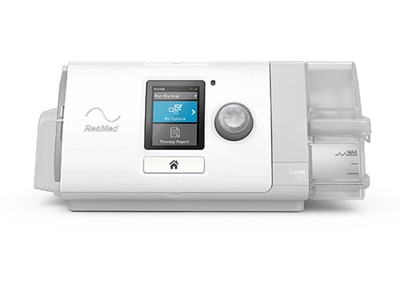
Understanding home high-flow therapy
High-flow therapy can provide effective relief of chronic COPD symptoms, like cough with mucous production, that can be difficult to manage with standard therapies alone. Learn about the key features and mechanisms of action of this respiratory therapy and discover how it can be used alongside or as an alternative to other treatments for COPD.
On this page, we refer exclusively to nasal home high-flow therapy, which is administered through a nasal cannula.

Home HFT and the GOLD COPD treatment pathway
HFT has benefits for hypoxemic COPD patients with frequent exacerbations in GOLD stages C and D*.1,6,7 GOLD B COPD patients could also benefit from symptom relief.6 HFT can be used with or without oxygen.

Key features of home high-flow therapy
HFT is designed to be administered via a nasal high-flow cannula (NHFC). This delivers a humidified mixture of air, with or without oxygen, that’s warmed to between 31°C and 37°C. Home HFT can supply flow ranging from 10 L/min to 60L/min. If oxygen is added, it can be delivered at up to 15 L/min. The configuration used depends on the needs of the patient.

LTOT, home HFT and home NIV therapy: similarities and differences
LTOT, home HFT and home NIV can be used separately or in combination for the home-based treatment of COPD patients.
- LTOT, HFT and home NIV can all improve oxygenation, reduce work of breathing and decrease cardiac load.
- HFT and home NIV can also improve tidal volume, decrease respiratory rate and improve PEEP.
- HFT can improve mucosal clearance and dead space clearance, which promotes comfort and tolerance.
- Home NIV helps COPD patients to benefit from improved alveolar ventilation and unloaded respiratory muscles.
Understanding the difference between hospital high-flow oxygen therapy (HFOT) and home HFT
Hospitals commonly use high-flow oxygen therapy for acute patients as an alternative to mechanical ventilation.
HFOT delivers high concentrations of oxygen and needs to be highly humidified to prevent it from feeling too dry and uncomfortable.
With home HFT, the aim is to help chronic patients to breathe more easily by providing them with heated, humidified air.
Oxygen is not a key component of HFT but it can be added if the patient has a prescription for long-term oxygen therapy (LTOT).
Home high-flow therapy FAQs
Yes. High-flow therapy systems have been designed for home use. The blower is located on the inside, and the design supports easy operation and training for home use.
Humidification plays a major role in HFT as it increases patient comfort and tolerability. Without humidification to condition the gases, HFT would be uncomfortably cold and dry.
Home high-flow therapy can be used during the day and/or at night. Hours of usage vary depending on the needs and condition of the patient.
According to an internal Resmed survey, 77% healthcare professionals prescribed home HFT to hypoxemic COPD patients for 8 or more hours in a day. 10
Home HFT can be indicated for hypoxemic COPD patients affected by chronic cough with mucous production. Learn more about research into HFT for this target population here.
No. HFT can be considered as a complementary therapy depending on the patient’s needs. This section explains the differences between HFT and PAP therapies.
High-flow therapy can be delivered with or without additional oxygen, depending on the needs of the patient. Oxygen can be added at flow rates of up to 15 L/min.
HFT is not suitable for hypercapnic patients as it does not provide ventilation or pressure support. Nevertheless, hypercapnic patients who use non-invasive ventilation (NIV) may find that HFT increases their comfort levels during their break off NIV.9
HFT can deliver an adjustable flow of 10-60L/min at a temperature of 31-37°C. Humidification levels can also be adjusted to improve comfort and manage condensation.
Research shows that HFT can start to have a noticeable effect after 1-2 hours of use6,7 and that around 6 hours of use, mainly during the night, could be a suitable daily target.6
Yes, high-flow therapy can be used while patients are sleeping and when they are awake. 77% of healthcare professionals prescribed home HFT to hypoxemic COPD patients during both sleep and daytime activities according to a Resmed internal survey.10
Yes. Flows and humidification have a positive peak inspiratory flow effect and oxygen is delivered more effectively during therapy, which is important during exercise.3 HFT has been shown to improve dyspnoea during exercise.2-4 As the heated humidifier contains water, care must be taken at all times when moving the device.8
No, the HFT device must not be used in transit, e.g. on a plane, in a car or in a wheelchair. This is due to the risk that they will inhale water or that water will spill into the device and damage it.
Noise levels vary depending on the device and settings. Home high-flow therapy devices are designed to be used during sleep and to allow patients to talk and engage in daily life during therapy. Resmed’s Lumis HFT device has an operating volume of 38 dBA +/- 2 dBA with ClimateLineAir tubing and 39 dBA +/- 2 dBA when used with ClimateLineAir tubing and 5 L/min supplementary oxygen (measured in HFT mode according to ISO 80601-2-74:2017).
This content is intended for health professionals only. Please refer to the user and clinical guides for relevant information related to any warnings and precautions to be considered before and during use of the products.
* The 2023 GOLD COPD guidelines now recognise three GOLD groups – “A”, “B”, and “E”. Group “E” (formerly groups C and D) are patients with frequent exacerbations (defined as 2 or more in the past 12 months or 1 exacerbation requiring hospitalisation).
- Hasani A, et al. Domiciliary humidification improves lung mucociliary
clearance in patients with bronchiectasis. Chron Respir Dis 2008;5:81-86. - Cirio S, Piran M, Vitacca M, Piaggi G, Ceriana P, Prazzoli M, et al. Effects of heated and humidified high flow gases during high-intensity constant load exercise on severe COPD patients with ventilatory limitation. Respiratory Medicine 2016;118:128–32.
- Neunhäuserer D, Steidle-Kloc E, Weiss G, Kaiser B, Niederseer D, Hartl S, et al. Supplemental Oxygen During High-Intensity Exercise Training in Nonhypoxemic Chronic Obstructive Pulmonary Disease. The American Journal of Medicine 2016;129(11):1185–93.
- Chatila W, Nugent T, Vance G, Gaughan J, Criner GJ. The Effects of High- Flow vs Low-Flow Oxygen on Exercise in Advanced Obstructive Airways Disease. Chest 2004;126(4):1108–15.
- Fraser JF, et al. Nasal high flow oxygen therapy in patients with COPD reduces respiratory rate and tissue carbon dioxide while increasing tidal and end-expiratory lung volumes: a randomised crossover trial. Thorax 2016;71:759-761.
- Storgaard LH, et al. Long-term effects of oxygen-enriched high-flow nasal cannula treatment in COPD patients with chronic hypoxemic respiratory failure. Int J Chron Obstruct Pulmon Dis 2018;13:1195-1205.
- Rea H, et al. The clinical utility of long-term humidification therapy in chronic airway disease. Respir Med 2010;104:525-533.
- Nagata K, Kikuchi T, Horie T, Shiraki A, Kitajima T, Kadowaki T, et al. Domiciliary High-Flow Nasal Cannula Oxygen Therapy for Stable Hypercapnic COPD Patients: A Multicenter, Randomized Crossover Trial. Annals of the American Thoracic Society. 2017.
- Spoletini G, Mega C, Pisani L, Alotaibi M, Khoja A, Price LL, Blasi F, Nava S, Hill NS. High-flow nasal therapy vs standard oxygen during breaks off noninvasive ventilation for acute respiratory failure: A pilot randomized controlled trial. J Crit Care. 2018 Dec;48:418-425. doi: 10.1016/j.jcrc.2018.10.004. Epub 2018 Oct 5. PMID: 30321833.
- Resmed customer survey of healthcare professionals, conducted between 18/03/2021 – 31/06-2021 – Data on file; ID C306968








